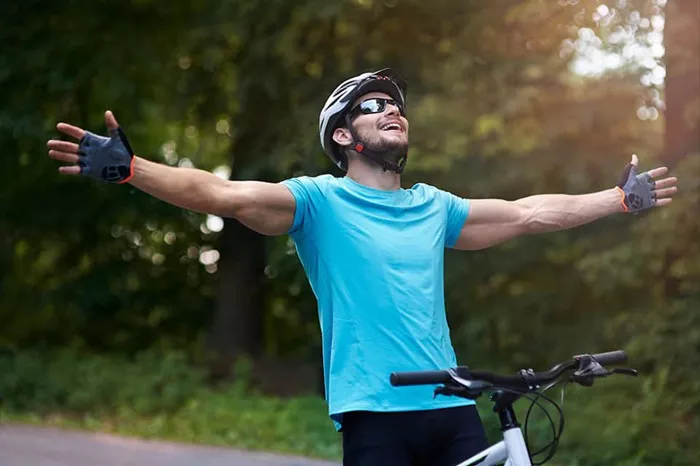Cycling is often seen as a lower-body workout. People think it only strengthens the legs, but that’s not entirely true. The upper body also plays a role in cycling, though not as much as the legs. Understanding how cycling affects the upper body can help riders improve their performance and overall fitness.
The Role of the Upper Body in Cycling
When you ride a bike, your legs do most of the work. They push the pedals, generating power to move the bike forward. However, the upper body is not completely inactive. The arms, shoulders, and core muscles help with balance, control, and stability.
On a road bike, riders often lean forward, placing some weight on the handlebars. This position engages the arms and shoulders to support the upper body. Mountain bikers use their upper body even more because they need to maneuver the bike over rough terrain. BMX riders rely heavily on their arms and shoulders for jumps and tricks.
Even in casual cycling, the upper body is involved. Holding the handlebars, turning, and maintaining posture all require some muscle engagement. While cycling won’t build big arm muscles like weightlifting, it does provide some toning and endurance benefits for the upper body.
Muscles Used in the Upper Body While Cycling
Several upper body muscles are active during cycling. The main ones include:
Shoulders (Deltoids): These muscles help stabilize the arms and assist in steering.
Arms (Biceps and Triceps): The biceps help with pulling motions, while the triceps help with pushing and supporting body weight.
Chest (Pectorals): These muscles assist in holding the handlebars and maintaining posture.
Back (Latissimus Dorsi and Rhomboids): These muscles help keep the spine stable and support proper riding posture.
Core (Abdominals and Obliques): A strong core improves balance and reduces strain on the arms and shoulders.
While these muscles are not the primary movers in cycling, they work isometrically—meaning they contract to hold positions rather than to produce movement. This type of muscle engagement improves endurance rather than size.
Does Cycling Build Upper Body Strength?
Cycling is not the best exercise for building upper body strength. The resistance is not high enough to cause significant muscle growth. However, it does help with muscle endurance. Long rides can make the arms and shoulders stronger over time, but they won’t become bulky.
For those who want bigger arms or a stronger chest, cycling alone won’t be enough. Adding weight training or bodyweight exercises like push-ups and pull-ups is necessary. However, for general fitness and toning, cycling provides enough engagement to keep the upper body active.
How to Engage the Upper Body More While Cycling
If you want to maximize upper body involvement during cycling, there are a few techniques you can try:
Ride Off-Road: Mountain biking and BMX require more upper body strength due to uneven terrain and quick movements.
Use a Bike with Flat Handlebars: Flat bars engage the arms and shoulders more than drop bars, which are common on road bikes.
Stand While Pedaling: When climbing hills or sprinting, standing on the pedals shifts more weight to the arms and shoulders.
Incorporate Intervals: High-intensity cycling forces the upper body to work harder to maintain control.
Focus on Core Strength: A strong core reduces reliance on the arms, but it also improves overall stability, making the upper body more efficient.
The Importance of Upper Body Strength for Cyclists
Even though cycling is leg-dominant, upper body strength matters. A strong upper body helps with:
- Better Control: Strong arms and shoulders improve bike handling, especially at high speeds or on rough roads.
- Reduced Fatigue: Weak upper muscles can lead to early exhaustion, making long rides harder.
- Improved Posture: A strong back and core prevent slouching, reducing neck and shoulder pain.
- Injury Prevention: Balanced muscle strength lowers the risk of overuse injuries.
Professional cyclists often include strength training in their routines to enhance performance. While they don’t aim for bodybuilder-like muscles, they do work on functional strength to support their riding.
Combining Cycling with Upper Body Workouts
For a balanced fitness routine, cyclists should add upper body exercises. Some effective options include:
- Push-Ups: Strengthen the chest, shoulders, and triceps.
- Pull-Ups: Build back and arm strength.
- Planks: Improve core stability, which supports the upper body during cycling.
- Dumbbell Rows: Target the upper back and shoulders.
- Shoulder Presses: Strengthen the deltoids for better bike control.
Doing these exercises 2-3 times a week can complement cycling and create a more well-rounded physique.
Common Upper Body Issues for Cyclists
Since cycling is not an upper-body dominant activity, some riders experience problems such as:
- Neck and Shoulder Pain: Leaning forward for long periods can strain these areas.
- Weak Arms: Without additional training, the arms may lack strength compared to the legs.
- Poor Posture: Slouching can lead to back discomfort over time.
- To prevent these issues, cyclists should stretch regularly, strengthen their upper body, and adjust bike fit to reduce strain.
Conclusion
Cycling is mainly a lower-body exercise, but the upper body still plays a supporting role. It helps with balance, control, and endurance rather than raw strength. While cycling alone won’t build big arm muscles, it does contribute to overall fitness. For those who want a stronger upper body, adding targeted exercises is the best approach. Whether you ride for fun, fitness, or competition, paying attention to upper body strength can improve performance and comfort on the bike.
Related topics:
- DOES CYCLING BURN FAT ALL OVER?
- DOES CYCLING BUILD STRENGTH?
- IS A RECUMBENT EXERCISE BIKE GOOD FOR WEIGHT LOSS?

